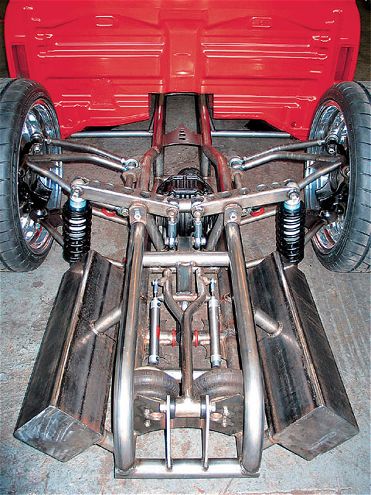
| rear Suspension Setup chassis
With the average mini-trucker comes the stigma that "do-it-yourself" is the way to go. Well, we're here to say that there's a reason professionals and engineers are in business to design functional suspensions. It's not necessarily as simple as slapping on a four-link and going to town. We're not here to scare anyone out of doing things themselves, but rather, we want to delve deeper into educating our readers and cover something no one has ever shed any real light on: rear suspension setup.
Why so much talk about rear suspension? It seems these days no self-respecting mini-truck is show-worthy without having an attention-commanding "Goldberg device" (Google it) hanging out of a cavernous hole in the bed. Most rear suspension designs are limited to certain confines that don't create many severe effects, but there are major design considerations that should be taken into account. Regardless of how you lift the frame off of the rearend, the links that connect the rearend to the chassis are what affect the dynamic relationship of the vehicle to the road. Before we go into the actual suspension designs I think it would benefit us to define the effects.
Every suspension design has its benefits. Even the tried-and-true four-link has infinite design options to be an advantage in one area more than the other. The dynamics that are affected by the design, that are important to us here, are:
* Roll center
* Roll steer
* Anti-squat
* Pinion angle
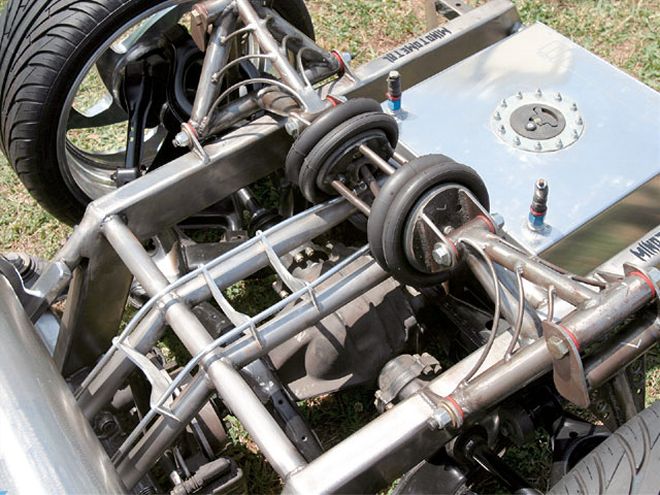
| rear Suspension Setup suspension
Also, before we even discuss these we need to define instantaneous center, or instant center. Instant center is a theoretical point in space that is used to calculate suspension effect. The way to find instant center is easy once you "get it." When you have two or more bars, arms, or whatever you are working with, each part is only as long as a straight line drawn from pivot to pivot. If you were to extend the line drawn through those points into theoretical "space" and do the same through the pivots of the other related parts, hopefully, at some point, they would meet. The point at which they meet is the instant center. If this doesn't make any sense, keep thinking about it until it does. To continue reading without understanding instant center is not going to be as beneficial.
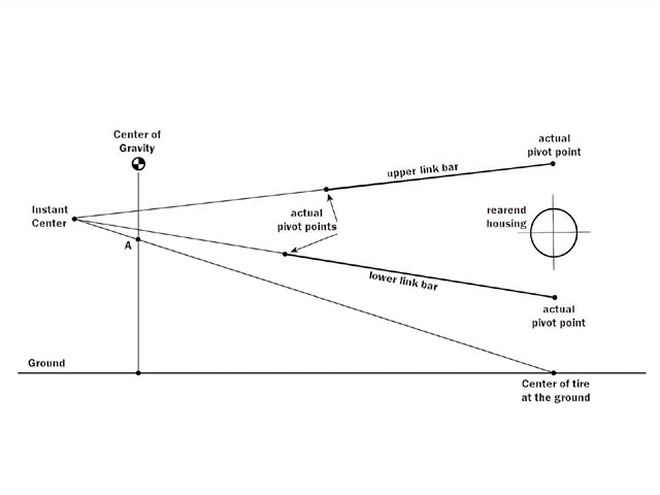
| The side view addresses many different design effects. Instant center, anti-squat, pinion angle, and roll steer are some of the effects that are calculated from this view. You can also see that it is impossible to tell what type of four-link (or three-link) is used when viewed from the side. Anti-squat is measured in percentage. The percent of the line from the ground to point A is the amount of anti-squat designed into the system.
Now that you know what instant center is, let's talk about roll center. Every suspension design sets a point at which the vehicle "rolls" from side to side. Most of the time the point moves around depending on where the suspension is in its travel, but it is still important. On a straight-axle-type rear suspension the roll center is "set" by whatever is used to eliminate lateral movement (e.g., Panhard bar or even a triangulated-type link system). What happens is that the center of gravity acts upon the vehicle through its roll center. The higher the roll center, the lower the vehicle feels in cornering. Don't get greedy, though. Too high of a roll center and the car will act odd. The chances of having a high roll center at the front suspension is not good, and the vehicle will act unbalanced. Any decent rear-suspension design will have a roll center around the center of the rearend, which is fine.
Anti-squat is really not a major concern, except that it should be at least taken into consideration while building a link system that is limited to short bars. Anti-squat also affects roll steer and vise-versa. (Roll center can also affect roll steer but isn't a concern with a properly designed system.) What anti-squat does is fight the effect of weight transfer trying to "squat" the rearend while under acceleration. To create or eliminate anti-squat, you would design the link system to have the instant center a certain height related to the center of gravity. A higher instant center has more anti-squat, while a lower instant center has less. At some point, too high of an instant center will actually lift the rear up as the vehicle accelerates. And too low will push the rear down (though a little tougher to achieve).
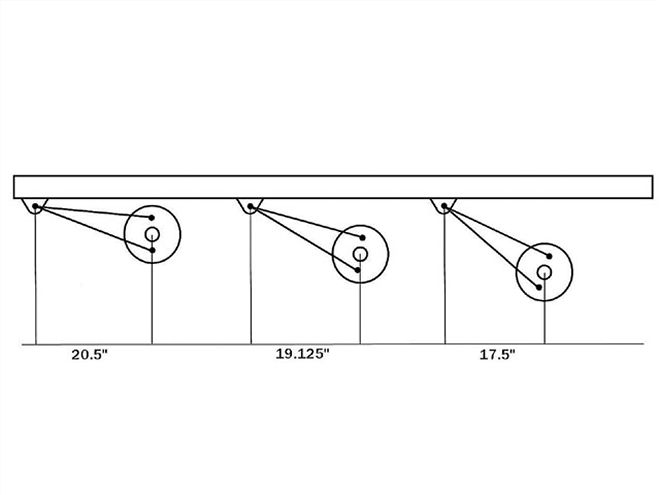
| Roll steer is induced is several different ways. The diagram shows the immediate issue of a poor design. As the suspension runs through its travel, the wheels move front-to-back in relation to the chassis. In a corner, the outside wheel would move back as the inside wheel would move forward, causing the vehicle to "self steer" into the corner.
Roll steer is a little more important and could cause some really poor dynamic effects. Roll steer also comes in flavors: roll understeer and roll oversteer. Every straight-axle rear-suspension design that actually affects performance has roll-steer in some amount. Roll steer is always measured when the car is leaning toward the outside of a corner. For example, if you were to turn left, the vehicle would lean to the right, so with the right rear wheel being compressed and the left wheel in droop, and geometry being what it is, the rearend would try to steer the vehicle into or out of the corner. The issue is caused when the rearend steers out of the corner, causing roll oversteer. What happens at the controls of the vehicle is, once the corner is entered and the vehicle takes its "set" into the corner, the rearend suddenly steers the car further than initially anticipated. Now, under normal driving conditions this is at best annoying, but really driving into a corner and having the rearend oversteer can put the car into a spin. In really severe conditions the vehicle would be extremely difficult to drive over 30 mph. A small bump in the road would really upset the chassis and almost can't be controlled. However, the confines of the typical mini-truck don't really leave much room for severe oversteer, and severe understeer is hard to achieve.
Pinion angle is probably the one thing that most builders are completely aware of but many are not sure how to set up properly. The pinion angle should be between one and three degrees pointed down. Most of us have already heard that, but the thing is that the major detail left out is that it should be one to three degrees pointed down from parallel to the transmission (or the front driveshaft on a two-piece driveline). What that means is the pinion could, under certain circumstances, point up. We don't have nearly enough space here for me to explain how to design the suspension that you may desire, but give us some time; we'll get there.
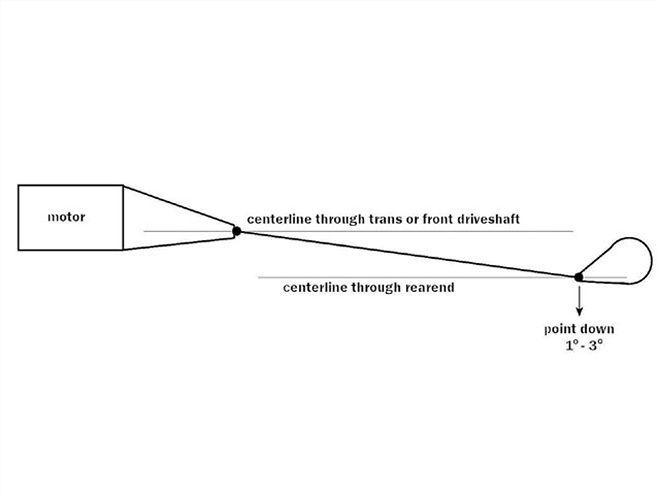
| Pinion angles should be kept near zero in relation to each other. The reason we would point pinion down a few degrees is to compensate for flex. But you can see from the diagram that the pinion angle can certainly be more than three degrees to be set up right.
Now that the boring part is over, let's get to the subject at hand: suspension design. I am going to describe the major benefits of each design. For a suspension design to be undrivable, it would have to be really bad. Also, if you just can't quite fit the perfect design into your confines, you will have to compromise. That's part of what makes a good fabricator, the ability to adapt to his limitations.
The ladder bar and two-link are both very similar. In fact, a ladder bar is a type of two-link, but not all two-links could be considered ladder bars. The ladder bar design is great for high horsepower, high traction cars that the owner doesn't want to spend the hours or days on it would take to tune a good four-link for the track. The first major downfall of the two-link is that it doesn't allow much articulation (one wheel up and one wheel down). The only way that the design can articulate is to flex a little bit of everything. NASCAR usesa two-link rear suspension that is specially engineered to allow an acceptable amount of flex in order to articulate. The second major issue is pinion angle.The two-link, by nature, cannot keep the pinion parallel to the transmission, so useable travel is limited to the acceptable amount of pinion change. On the other hand, the two-link is fairly easy to tune, to install, and to purchase. Anti-squat is easy to figure because the instant center is the forward pivot. Roll center and roll steer aren't really a concern because the suspension won't articulate, so on the same coin, the need for a sway bar is just not there either. The two-link will require a Panhard bar, track locator, or other similar lateral limiter.
The four-link is separated into three major types:
* Triangulated four-link
* Parallel four-link
* Three-link
Each of these designs has the same advantages and can be oriented as forward, reverse, or "2-forward, 2-reverse." Initially, I am only going to talk about the forward-facing orientation. Once we have described the advantages of those, I will explain the downfall of each of the other orientations. The reason that the three-link is categorized here is that just about every advantage and disadvantage is shared by all three of these systems. In fact, the three-link and parallel four-link are identical except the missing link. It is a space-saver-period.
The way that a link system of this type is drawn out is two-dimensionally, from the side. From that view you cannot tell which design is used. The side view is how you would figure instant center, anti-squat, pinion angle, and a portion of roll steer. Because of the infinite possibilities of the four-link, they are used on just about every straight-axle rear suspension in the performance industry (factory or aftermarket). Good control of the pinion is possible (assuming the designer took it into consideration). They also have infinite instant center options. As a matter of fact, the drag-race community has four-link designs that allow tuning of the instant center separately from one side to the other. Again, the confines and the fear of most builders to "step out of the box" has limited our designs, but the limitations have been on the side of caution. Having an instant center around the front bumper or beyond has very little adverse effect. This is how the manufacturers set up their link systems.
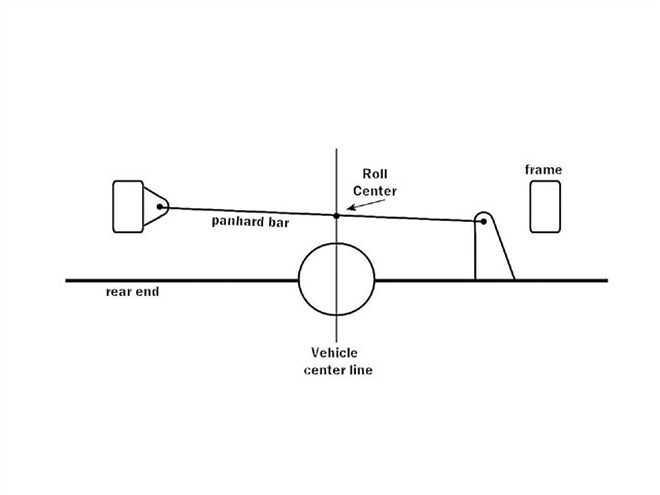
| From the rear the link bars are of little importance-only if the system chosen is a wishbone-type three-link. If that is the case, then the point at which the wishbone meets is the roll center. If a Panhard bar is chosen (shown), then the point at which the Panhard bar intersects the centerline of the vehicle is the roll center.
The separation of each of these designs is from above. From this view you can see how each bar is run. The triangulated four-link would be the most obvious and is what is most commonly used in the mini-truck industry. The triangulated four-link does not need a Panhard bar or any other lateral limiter. (The triangulation of the bars does the limiting for us.) This would be a good time to touch on the "wishbone"-type three-link. What this system does is bring the close ends of the triangulated into each other, creating the wishbone. It acts exactly like the triangulated four-link, except that the single point of the wishbone is the roll center. Mini-trucks don't really use this system because of space limitations. Early Cadillacs used this system and had a reputation of breaking the ball joint used at the single point. The overhead view is also another addition to the roll steer picture. By pointing the bars towards the front or rear of the vehicle, it can change the roll steer effect.
The three-link and parallel four-link need a lateral limiter of some sort, which would be viewed from the rear (in most cases): a Panhard bar, track locator (viewed from above), Watts link, etc. There are many different ways to limit lateral movement and all have their advantages and disadvantages. But that's for another day
Forward, reverse-what's the difference? A forward-facing four-link transfers energy to the chassis, planting the rearend under power and a small amount of anti-dive under braking; and it can be tuned infinitely for a specific purpose. A reverse four-link, on the other hand, should only be used as a compromise. They will drive fine and turn corners and stop the car without too much upset, but again, as I've stated several times before, "the confines of the mini-truck do not leave much room for dangerous designs." On top of that, there aren't bucket-loads of horsepower pouring out of the average mini-truck and if so, it usually doesn't make it to the ground. Another saving grace of the reverse orientation is that roll steer is almost always roll understeer, making the truck feel stable in corners. Also, the pinion angle, when properly designed, is kept well within working limits. The point is, the reverse four-link works. It holds the truck off of the ground and keeps the rearend under the truck.
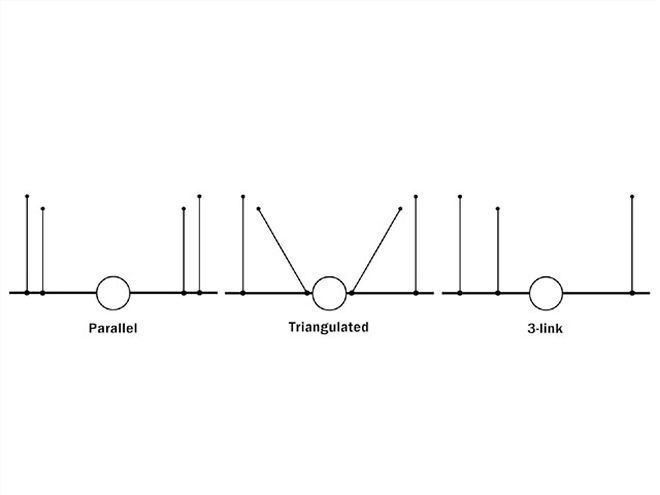
| You can see from the top view that all of the mounting points are the same distance from front to rear but only differ from each other by bar orientation. The parallel four-link and three-link bars can also run on top of each other, making the top view look like a simple two-link.
The 2-forward, 2-reverse works because it does nothing. It doesn't help, it doesn't hurt...nothing. The biggest issue with the 2-forward,2-reverse is pinion angle. It's a little tough to calculate and doesn't offer much travel because of this. On an odd note, this system doesn't move much front-to-rear as it runs through its travel. We've never seen the reverse four-link or the 2-forward, 2-reverse-type four-link used anywhere else except the mini-truckin' industry. Bob Grant called me the other day and challenged me to figure out how to build a rear suspension that doesn't move front-to-back in the wheelwell. I immediately thought "A-arm." Then he clarified "straight axle." I then promptly said that it could not be done. Then he told me his idea. It would work, but if the rearend does not follow a set point in space (instant center), it will not add or subtract anything to the cause of traction.
Well, we hope you were able to get through this and decipher the cryptic writings about the black magic of link-type suspension. Stay tuned as Max reveals more and more suspension wisdom for our quest of knowledge.
 | rear Suspension Setup chassis
With the average mini-trucker comes the stigma that "do-it-yourself" is the way to go. Well, we're here to say that there's a reason professionals and engineers are in business to design functional suspensions. It's not necessarily as simple as slapping on a four-link and going to town. We're not here to scare anyone out of doing things themselves, but rather, we want to delve deeper into educating our readers and cover something no one has ever shed any real light on: rear suspension setup.
Why so much talk about rear suspension? It seems these days no self-respecting mini-truck is show-worthy without having an attention-commanding "Goldberg device" (Google it) hanging out of a cavernous hole in the bed. Most rear suspension designs are limited to certain confines that don't create many severe effects, but there are major design considerations that should be taken into account. Regardless of how you lift the frame off of the rearend, the links that connect the rearend to the chassis are what affect the dynamic relationship of the vehicle to the road. Before we go into the actual suspension designs I think it would benefit us to define the effects.
Every suspension design has its benefits. Even the tried-and-true four-link has infinite design options to be an advantage in one area more than the other. The dynamics that are affected by the design, that are important to us here, are:
| rear Suspension Setup chassis
With the average mini-trucker comes the stigma that "do-it-yourself" is the way to go. Well, we're here to say that there's a reason professionals and engineers are in business to design functional suspensions. It's not necessarily as simple as slapping on a four-link and going to town. We're not here to scare anyone out of doing things themselves, but rather, we want to delve deeper into educating our readers and cover something no one has ever shed any real light on: rear suspension setup.
Why so much talk about rear suspension? It seems these days no self-respecting mini-truck is show-worthy without having an attention-commanding "Goldberg device" (Google it) hanging out of a cavernous hole in the bed. Most rear suspension designs are limited to certain confines that don't create many severe effects, but there are major design considerations that should be taken into account. Regardless of how you lift the frame off of the rearend, the links that connect the rearend to the chassis are what affect the dynamic relationship of the vehicle to the road. Before we go into the actual suspension designs I think it would benefit us to define the effects.
Every suspension design has its benefits. Even the tried-and-true four-link has infinite design options to be an advantage in one area more than the other. The dynamics that are affected by the design, that are important to us here, are: | rear Suspension Setup suspension
Also, before we even discuss these we need to define instantaneous center, or instant center. Instant center is a theoretical point in space that is used to calculate suspension effect. The way to find instant center is easy once you "get it." When you have two or more bars, arms, or whatever you are working with, each part is only as long as a straight line drawn from pivot to pivot. If you were to extend the line drawn through those points into theoretical "space" and do the same through the pivots of the other related parts, hopefully, at some point, they would meet. The point at which they meet is the instant center. If this doesn't make any sense, keep thinking about it until it does. To continue reading without understanding instant center is not going to be as beneficial.
| rear Suspension Setup suspension
Also, before we even discuss these we need to define instantaneous center, or instant center. Instant center is a theoretical point in space that is used to calculate suspension effect. The way to find instant center is easy once you "get it." When you have two or more bars, arms, or whatever you are working with, each part is only as long as a straight line drawn from pivot to pivot. If you were to extend the line drawn through those points into theoretical "space" and do the same through the pivots of the other related parts, hopefully, at some point, they would meet. The point at which they meet is the instant center. If this doesn't make any sense, keep thinking about it until it does. To continue reading without understanding instant center is not going to be as beneficial.
 | The side view addresses many different design effects. Instant center, anti-squat, pinion angle, and roll steer are some of the effects that are calculated from this view. You can also see that it is impossible to tell what type of four-link (or three-link) is used when viewed from the side. Anti-squat is measured in percentage. The percent of the line from the ground to point A is the amount of anti-squat designed into the system.
Now that you know what instant center is, let's talk about roll center. Every suspension design sets a point at which the vehicle "rolls" from side to side. Most of the time the point moves around depending on where the suspension is in its travel, but it is still important. On a straight-axle-type rear suspension the roll center is "set" by whatever is used to eliminate lateral movement (e.g., Panhard bar or even a triangulated-type link system). What happens is that the center of gravity acts upon the vehicle through its roll center. The higher the roll center, the lower the vehicle feels in cornering. Don't get greedy, though. Too high of a roll center and the car will act odd. The chances of having a high roll center at the front suspension is not good, and the vehicle will act unbalanced. Any decent rear-suspension design will have a roll center around the center of the rearend, which is fine.
Anti-squat is really not a major concern, except that it should be at least taken into consideration while building a link system that is limited to short bars. Anti-squat also affects roll steer and vise-versa. (Roll center can also affect roll steer but isn't a concern with a properly designed system.) What anti-squat does is fight the effect of weight transfer trying to "squat" the rearend while under acceleration. To create or eliminate anti-squat, you would design the link system to have the instant center a certain height related to the center of gravity. A higher instant center has more anti-squat, while a lower instant center has less. At some point, too high of an instant center will actually lift the rear up as the vehicle accelerates. And too low will push the rear down (though a little tougher to achieve).
| The side view addresses many different design effects. Instant center, anti-squat, pinion angle, and roll steer are some of the effects that are calculated from this view. You can also see that it is impossible to tell what type of four-link (or three-link) is used when viewed from the side. Anti-squat is measured in percentage. The percent of the line from the ground to point A is the amount of anti-squat designed into the system.
Now that you know what instant center is, let's talk about roll center. Every suspension design sets a point at which the vehicle "rolls" from side to side. Most of the time the point moves around depending on where the suspension is in its travel, but it is still important. On a straight-axle-type rear suspension the roll center is "set" by whatever is used to eliminate lateral movement (e.g., Panhard bar or even a triangulated-type link system). What happens is that the center of gravity acts upon the vehicle through its roll center. The higher the roll center, the lower the vehicle feels in cornering. Don't get greedy, though. Too high of a roll center and the car will act odd. The chances of having a high roll center at the front suspension is not good, and the vehicle will act unbalanced. Any decent rear-suspension design will have a roll center around the center of the rearend, which is fine.
Anti-squat is really not a major concern, except that it should be at least taken into consideration while building a link system that is limited to short bars. Anti-squat also affects roll steer and vise-versa. (Roll center can also affect roll steer but isn't a concern with a properly designed system.) What anti-squat does is fight the effect of weight transfer trying to "squat" the rearend while under acceleration. To create or eliminate anti-squat, you would design the link system to have the instant center a certain height related to the center of gravity. A higher instant center has more anti-squat, while a lower instant center has less. At some point, too high of an instant center will actually lift the rear up as the vehicle accelerates. And too low will push the rear down (though a little tougher to achieve).
 | Roll steer is induced is several different ways. The diagram shows the immediate issue of a poor design. As the suspension runs through its travel, the wheels move front-to-back in relation to the chassis. In a corner, the outside wheel would move back as the inside wheel would move forward, causing the vehicle to "self steer" into the corner.
Roll steer is a little more important and could cause some really poor dynamic effects. Roll steer also comes in flavors: roll understeer and roll oversteer. Every straight-axle rear-suspension design that actually affects performance has roll-steer in some amount. Roll steer is always measured when the car is leaning toward the outside of a corner. For example, if you were to turn left, the vehicle would lean to the right, so with the right rear wheel being compressed and the left wheel in droop, and geometry being what it is, the rearend would try to steer the vehicle into or out of the corner. The issue is caused when the rearend steers out of the corner, causing roll oversteer. What happens at the controls of the vehicle is, once the corner is entered and the vehicle takes its "set" into the corner, the rearend suddenly steers the car further than initially anticipated. Now, under normal driving conditions this is at best annoying, but really driving into a corner and having the rearend oversteer can put the car into a spin. In really severe conditions the vehicle would be extremely difficult to drive over 30 mph. A small bump in the road would really upset the chassis and almost can't be controlled. However, the confines of the typical mini-truck don't really leave much room for severe oversteer, and severe understeer is hard to achieve.
Pinion angle is probably the one thing that most builders are completely aware of but many are not sure how to set up properly. The pinion angle should be between one and three degrees pointed down. Most of us have already heard that, but the thing is that the major detail left out is that it should be one to three degrees pointed down from parallel to the transmission (or the front driveshaft on a two-piece driveline). What that means is the pinion could, under certain circumstances, point up. We don't have nearly enough space here for me to explain how to design the suspension that you may desire, but give us some time; we'll get there.
| Roll steer is induced is several different ways. The diagram shows the immediate issue of a poor design. As the suspension runs through its travel, the wheels move front-to-back in relation to the chassis. In a corner, the outside wheel would move back as the inside wheel would move forward, causing the vehicle to "self steer" into the corner.
Roll steer is a little more important and could cause some really poor dynamic effects. Roll steer also comes in flavors: roll understeer and roll oversteer. Every straight-axle rear-suspension design that actually affects performance has roll-steer in some amount. Roll steer is always measured when the car is leaning toward the outside of a corner. For example, if you were to turn left, the vehicle would lean to the right, so with the right rear wheel being compressed and the left wheel in droop, and geometry being what it is, the rearend would try to steer the vehicle into or out of the corner. The issue is caused when the rearend steers out of the corner, causing roll oversteer. What happens at the controls of the vehicle is, once the corner is entered and the vehicle takes its "set" into the corner, the rearend suddenly steers the car further than initially anticipated. Now, under normal driving conditions this is at best annoying, but really driving into a corner and having the rearend oversteer can put the car into a spin. In really severe conditions the vehicle would be extremely difficult to drive over 30 mph. A small bump in the road would really upset the chassis and almost can't be controlled. However, the confines of the typical mini-truck don't really leave much room for severe oversteer, and severe understeer is hard to achieve.
Pinion angle is probably the one thing that most builders are completely aware of but many are not sure how to set up properly. The pinion angle should be between one and three degrees pointed down. Most of us have already heard that, but the thing is that the major detail left out is that it should be one to three degrees pointed down from parallel to the transmission (or the front driveshaft on a two-piece driveline). What that means is the pinion could, under certain circumstances, point up. We don't have nearly enough space here for me to explain how to design the suspension that you may desire, but give us some time; we'll get there.
 | Pinion angles should be kept near zero in relation to each other. The reason we would point pinion down a few degrees is to compensate for flex. But you can see from the diagram that the pinion angle can certainly be more than three degrees to be set up right.
Now that the boring part is over, let's get to the subject at hand: suspension design. I am going to describe the major benefits of each design. For a suspension design to be undrivable, it would have to be really bad. Also, if you just can't quite fit the perfect design into your confines, you will have to compromise. That's part of what makes a good fabricator, the ability to adapt to his limitations.
The ladder bar and two-link are both very similar. In fact, a ladder bar is a type of two-link, but not all two-links could be considered ladder bars. The ladder bar design is great for high horsepower, high traction cars that the owner doesn't want to spend the hours or days on it would take to tune a good four-link for the track. The first major downfall of the two-link is that it doesn't allow much articulation (one wheel up and one wheel down). The only way that the design can articulate is to flex a little bit of everything. NASCAR usesa two-link rear suspension that is specially engineered to allow an acceptable amount of flex in order to articulate. The second major issue is pinion angle.The two-link, by nature, cannot keep the pinion parallel to the transmission, so useable travel is limited to the acceptable amount of pinion change. On the other hand, the two-link is fairly easy to tune, to install, and to purchase. Anti-squat is easy to figure because the instant center is the forward pivot. Roll center and roll steer aren't really a concern because the suspension won't articulate, so on the same coin, the need for a sway bar is just not there either. The two-link will require a Panhard bar, track locator, or other similar lateral limiter.
The four-link is separated into three major types:
| Pinion angles should be kept near zero in relation to each other. The reason we would point pinion down a few degrees is to compensate for flex. But you can see from the diagram that the pinion angle can certainly be more than three degrees to be set up right.
Now that the boring part is over, let's get to the subject at hand: suspension design. I am going to describe the major benefits of each design. For a suspension design to be undrivable, it would have to be really bad. Also, if you just can't quite fit the perfect design into your confines, you will have to compromise. That's part of what makes a good fabricator, the ability to adapt to his limitations.
The ladder bar and two-link are both very similar. In fact, a ladder bar is a type of two-link, but not all two-links could be considered ladder bars. The ladder bar design is great for high horsepower, high traction cars that the owner doesn't want to spend the hours or days on it would take to tune a good four-link for the track. The first major downfall of the two-link is that it doesn't allow much articulation (one wheel up and one wheel down). The only way that the design can articulate is to flex a little bit of everything. NASCAR usesa two-link rear suspension that is specially engineered to allow an acceptable amount of flex in order to articulate. The second major issue is pinion angle.The two-link, by nature, cannot keep the pinion parallel to the transmission, so useable travel is limited to the acceptable amount of pinion change. On the other hand, the two-link is fairly easy to tune, to install, and to purchase. Anti-squat is easy to figure because the instant center is the forward pivot. Roll center and roll steer aren't really a concern because the suspension won't articulate, so on the same coin, the need for a sway bar is just not there either. The two-link will require a Panhard bar, track locator, or other similar lateral limiter.
The four-link is separated into three major types:  | From the rear the link bars are of little importance-only if the system chosen is a wishbone-type three-link. If that is the case, then the point at which the wishbone meets is the roll center. If a Panhard bar is chosen (shown), then the point at which the Panhard bar intersects the centerline of the vehicle is the roll center.
The separation of each of these designs is from above. From this view you can see how each bar is run. The triangulated four-link would be the most obvious and is what is most commonly used in the mini-truck industry. The triangulated four-link does not need a Panhard bar or any other lateral limiter. (The triangulation of the bars does the limiting for us.) This would be a good time to touch on the "wishbone"-type three-link. What this system does is bring the close ends of the triangulated into each other, creating the wishbone. It acts exactly like the triangulated four-link, except that the single point of the wishbone is the roll center. Mini-trucks don't really use this system because of space limitations. Early Cadillacs used this system and had a reputation of breaking the ball joint used at the single point. The overhead view is also another addition to the roll steer picture. By pointing the bars towards the front or rear of the vehicle, it can change the roll steer effect.
The three-link and parallel four-link need a lateral limiter of some sort, which would be viewed from the rear (in most cases): a Panhard bar, track locator (viewed from above), Watts link, etc. There are many different ways to limit lateral movement and all have their advantages and disadvantages. But that's for another day
Forward, reverse-what's the difference? A forward-facing four-link transfers energy to the chassis, planting the rearend under power and a small amount of anti-dive under braking; and it can be tuned infinitely for a specific purpose. A reverse four-link, on the other hand, should only be used as a compromise. They will drive fine and turn corners and stop the car without too much upset, but again, as I've stated several times before, "the confines of the mini-truck do not leave much room for dangerous designs." On top of that, there aren't bucket-loads of horsepower pouring out of the average mini-truck and if so, it usually doesn't make it to the ground. Another saving grace of the reverse orientation is that roll steer is almost always roll understeer, making the truck feel stable in corners. Also, the pinion angle, when properly designed, is kept well within working limits. The point is, the reverse four-link works. It holds the truck off of the ground and keeps the rearend under the truck.
| From the rear the link bars are of little importance-only if the system chosen is a wishbone-type three-link. If that is the case, then the point at which the wishbone meets is the roll center. If a Panhard bar is chosen (shown), then the point at which the Panhard bar intersects the centerline of the vehicle is the roll center.
The separation of each of these designs is from above. From this view you can see how each bar is run. The triangulated four-link would be the most obvious and is what is most commonly used in the mini-truck industry. The triangulated four-link does not need a Panhard bar or any other lateral limiter. (The triangulation of the bars does the limiting for us.) This would be a good time to touch on the "wishbone"-type three-link. What this system does is bring the close ends of the triangulated into each other, creating the wishbone. It acts exactly like the triangulated four-link, except that the single point of the wishbone is the roll center. Mini-trucks don't really use this system because of space limitations. Early Cadillacs used this system and had a reputation of breaking the ball joint used at the single point. The overhead view is also another addition to the roll steer picture. By pointing the bars towards the front or rear of the vehicle, it can change the roll steer effect.
The three-link and parallel four-link need a lateral limiter of some sort, which would be viewed from the rear (in most cases): a Panhard bar, track locator (viewed from above), Watts link, etc. There are many different ways to limit lateral movement and all have their advantages and disadvantages. But that's for another day
Forward, reverse-what's the difference? A forward-facing four-link transfers energy to the chassis, planting the rearend under power and a small amount of anti-dive under braking; and it can be tuned infinitely for a specific purpose. A reverse four-link, on the other hand, should only be used as a compromise. They will drive fine and turn corners and stop the car without too much upset, but again, as I've stated several times before, "the confines of the mini-truck do not leave much room for dangerous designs." On top of that, there aren't bucket-loads of horsepower pouring out of the average mini-truck and if so, it usually doesn't make it to the ground. Another saving grace of the reverse orientation is that roll steer is almost always roll understeer, making the truck feel stable in corners. Also, the pinion angle, when properly designed, is kept well within working limits. The point is, the reverse four-link works. It holds the truck off of the ground and keeps the rearend under the truck.
 | You can see from the top view that all of the mounting points are the same distance from front to rear but only differ from each other by bar orientation. The parallel four-link and three-link bars can also run on top of each other, making the top view look like a simple two-link.
The 2-forward, 2-reverse works because it does nothing. It doesn't help, it doesn't hurt...nothing. The biggest issue with the 2-forward,2-reverse is pinion angle. It's a little tough to calculate and doesn't offer much travel because of this. On an odd note, this system doesn't move much front-to-rear as it runs through its travel. We've never seen the reverse four-link or the 2-forward, 2-reverse-type four-link used anywhere else except the mini-truckin' industry. Bob Grant called me the other day and challenged me to figure out how to build a rear suspension that doesn't move front-to-back in the wheelwell. I immediately thought "A-arm." Then he clarified "straight axle." I then promptly said that it could not be done. Then he told me his idea. It would work, but if the rearend does not follow a set point in space (instant center), it will not add or subtract anything to the cause of traction.
Well, we hope you were able to get through this and decipher the cryptic writings about the black magic of link-type suspension. Stay tuned as Max reveals more and more suspension wisdom for our quest of knowledge.
| You can see from the top view that all of the mounting points are the same distance from front to rear but only differ from each other by bar orientation. The parallel four-link and three-link bars can also run on top of each other, making the top view look like a simple two-link.
The 2-forward, 2-reverse works because it does nothing. It doesn't help, it doesn't hurt...nothing. The biggest issue with the 2-forward,2-reverse is pinion angle. It's a little tough to calculate and doesn't offer much travel because of this. On an odd note, this system doesn't move much front-to-rear as it runs through its travel. We've never seen the reverse four-link or the 2-forward, 2-reverse-type four-link used anywhere else except the mini-truckin' industry. Bob Grant called me the other day and challenged me to figure out how to build a rear suspension that doesn't move front-to-back in the wheelwell. I immediately thought "A-arm." Then he clarified "straight axle." I then promptly said that it could not be done. Then he told me his idea. It would work, but if the rearend does not follow a set point in space (instant center), it will not add or subtract anything to the cause of traction.
Well, we hope you were able to get through this and decipher the cryptic writings about the black magic of link-type suspension. Stay tuned as Max reveals more and more suspension wisdom for our quest of knowledge.